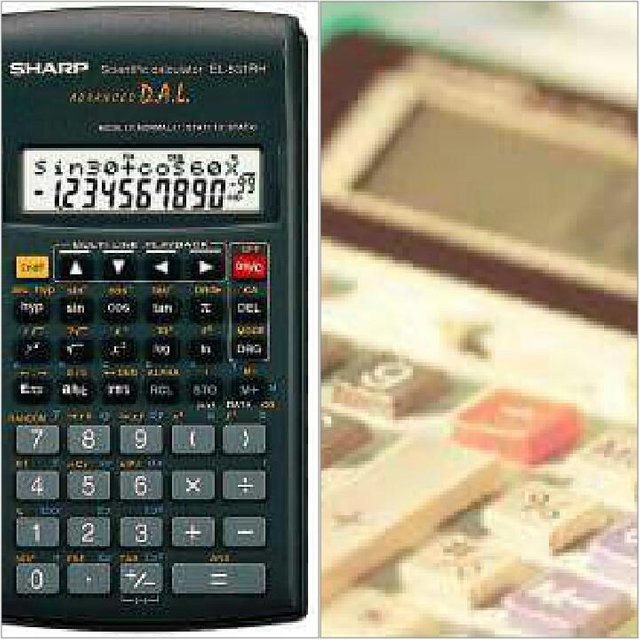Dear steemian friends.
Today, almost everyone uses a calculator in his life to do the calculations except for schoolchildren. Using the calculator effectively is an important skill. This skill is best learned by using a calculator regularly and meaningfully. As well as the use of a calculator at the time of calculation in a shopping center or wholesale.
A. TYPE CALCULATOR
Nowadays we have known several kinds of calculators from different brands and types, but can be classified into two types of calculators:
1. Calculator that can not be programmed.
This type of calculator can only be used for a simple calculation, which uses only ordinary calculation operations such as multiplication, division, addition, subtraction, logarithm, trigonometric function value.
2. Programmable Calculator.
In this type of calculator can be divided into two types of programming are:
a. Application programs that have been designed by the manufacturer. This program is already available, so users can directly use the facility. Examples: programs for statistics, linear regression analysis, integral and so on.
b. Programs created by the users themselves. The program is self-made in accordance with the need of the formula to be programmed by using "program language" for the calculator. A program that has been compiled can be inferred on the calculator and the stored program will not be lost even if the calculator is turned off.
But on the other side of the type of calculator there are only two definite differences, namely SCIENTIFIC calculators, and ordinary calculators.

How to distinguish the two types of calculator? The simplest way to tell the difference is, usually a scientific calculator has more buttons than a regular calculator, because usually a scientific calculator has additional functions such as trigonometric to light programming.
Scientific calculators typically have "scientific calculator" writings on their body, usually under the brand.
Another way is to enter the following operation on the calculator, ie 1 + 2 x 3. Do it, the scientific calculator will give 7, while the ordinary calculator gives answer 9.
3.Graphic Calculator.
Graph calculator is a type of calculator that is widely used in the field of engineering (science) this is because garfik calculator offers many features and ease in processing data of technocrats (people who are involved in the field of engineering).
Usually calculators categorized into the technical calculator is able to solve the problem - math problems in a high degree of complexity, one example of this type of circulator in the market is the SHARP EL-9900.
In terms of mathematics learning, graphic calculators have many benefits, including helping to understand mathematical concepts, strengthening the ability of commutation, developing high-level thinking skills, and problem solving.
There are several aspects of the use of graphing calculators in mathematics learning, namely:
- Graphing calculator is useful for determining and matching graphic images;
- Graphing calculators are useful for determining and matching answers to the set of resolutions;
- Graphing calculator to give you real experience about graphic images;
- Problem solving equations and inequalities can use commands, symbolic manipulations and graphs.
- Graphing calculators are helpful to provide previously calculated answers without a calculator and speed up the completion of a metaphor problem.
- The obstacles that students experience in using a graphing calculator is to phrase the mathematical sentence into the language of the calculator and reveal each calculator screen display into a mathematical sentence.
- Graphing calculators make math more interesting and solving math problems easier.
- If the use of a graphic calculator without being balanced with the ability to understand operating procedures and mathematical thinking then it can lead to high levels of dependence, loss of self-indulgence, and lazy thinking.
B. USE AND IMPACT OF COMPUTATION TECHNOLOGY
Based on the results of the study, Weaver (1981) concluded: ".... the use of calculators in various ways to investigate the outcome of a problem solving of the various grade levels, the evidence suggests that we find reasons to be cautious about the effects associated with the use calculator. In this case rarely found clear research literature.
In a recent study of the effects of long-term use of calculators for children, Groves and Stacey (1998) can be inferred
- Students will not rely on the use of calculators "they sacrifice the ability to use other calculation methods.
- Students who learn math using a calculator have higher mathematical achievement than students who do not use calculators, either at anytime and anywhere when they will use calculations.
- Students who learn mathematics by using calculators signifi- cantly show more understanding than negative numbers, large number of places, and especially decimals.
- Students who learn math by using the calculator perform better in their answer, especially in decimal calculations.
The calculator successfully helped introduce the basic concepts of calculus, Gimmestad (1982) concluded that: - Students sometimes change their answers to be more correct because they access the calculator
- Students who use calculators are more effective at exploring ideas or solutions to approaches in the context of problems
- Students using calculators are much more likely to check their work with systematic steps
- Students use the calculator to achieve a whole at the same level as students without a calculator.
Calculator boost:
- Students can use deductive reasoning
- Their ability to describe strategy retrospectively
- Techniques of using specific problem-solving techniques to achieve successful and solutions
- Ability to evaluate their progress in solving problems (Kelly, 1985)
Students using a calculator outperform students who do not use calculators (where the use of an optional calculator from students).
Review research on the impact of the use of calculators on mathematics in the classroom, Wheatley (1980) and Shumway et al. (1981) together conclude: - Students who use the calculator have greater knowledge in various mathematical concepts and calculations.
- Students who are weak in remembering basic facts, they become more successful in solving problems when given access calculator.
- Students who use calculators become more confident when solving problems
- Students using a calculator show more exploratory behavior when solving problems
- Students who use the calculator can spend more time in solving problems and lack of time on computing
- Teacher and student attitudes increase as the calculator is used as part of the classroom routine.
In their survey of 79 studies, Hembree and Dessart (1986) concluded: "At all levels of class, the use of calculators in concepts with traditional math learning to improve students' basic basic skills with both paper and pencil, both in vocational training and in problem solving ... in all classes and skill levels, students who use calculators have better attitude toward math and self-concept especially good in math than students who do not use calculators.
Students who use the Graphics calculator in the Precalculus class tend to perform better at critical thinking steps than students who do not use calculators (Farrell, 1989)
Gender differences in graphic task performance at college in algebra classes tend to disappear when students use graphing calculators (Dunham, 1990)
The Graphing Calculator changes the nature of classroom interactions and the role of teachers, encouraging student discussions with more teachers to play the role of consultants (Farrell, 1990; Rich, 1990)
The Graphing calculator facilitates algebra learning in several ways.
Graphing calculators give students the power to handle the 'Make Connection' process by themselves appropriately.
The impact of the computer environment on students' attitudes and affective responses of instruction in algebra and geometry. In addition to changing the social context associated with traditional instruction, computer access provides mechanisms for students to discover their own faults, thus eliminating the need beyond the authority of teachers (Kaput, 1989)
Students learn math more sophisticated in a short time and with a level of conceptual understanding in a manipulative symbolic computer environment (palmiter, 1986)
The computer environment can help students cope with misunderstanding of statistics because students control themselves important variables when they see the sampling process or manipulate the histogram (Rubin and Rosebery 1990)
Students need experience in simulating computers, computer spreadsheets and data analysis programs if they want to improve their understanding of opportunities and statistics (Shaughnessy, 1992)
Yerushalmy et al. (1986) examines the impact of geomtrical ligging on computers (eg, The Supposer) concludes:
a. Students from all levels can search for capabilities and geometrically construct concepts and accept them as common prototypes
b. Students have difficulty making allegations based on their exploration or data
c. Students should not feel justified in their limited generalization of the number of cases.
Students learn in computer and algebra environments related to the curriculum and perform better on mathematical modeling tasks, common problems solving tasks, and even tasks involving standard algebraic manipulations (J. Fey and K. Heid Algebra project results reported by Kieran, 1990)
Computer environments such as microworlds and simulations provide informal and assessment in the form of "snapshots" of students' work as they explore mathematical ideas (Shaughnessy, 1992)
The dynamic geometry software program creates a rich environment that improves student communication using math and helps students build relationships between different mathematical ideas (Brown et al., 1989)
Interactive computing technology improves both teaching and learning of mathematics. Great benefits happen if the power of that technology
- Can be controlled by both students and teachers
- Easily accessible in ways that allow students to explore, and
- Promoting student generalizations (Demana and Waits, 1990)
The Graphing calculator generates a data table that helps students explore meaningful learning before learning algebraic techniques. The end result is a student's enhanced understanding of the dynamics of change and the underlying meaning of algebraic expressions (Heid and Kunkle, 1998)
Students use graphical tools on calculators or computers have problems with scale when learning their functions and graphs. A common misconception is that change in scale also changes the values on the graph, with students realizing that the real change is their perception of the graph or the number of graphs seen on the screen (Leinhardt et al., 1990)
The power of the calculator and the computer makes "the organization and structure of algebraic problems. "Easy access to graphical representations and symbolic manipulators reduces the need to manipulate algebraic expressions or solve algebraic equations (Romberg, 1992)
The graph option on the calculator provides a dynamic visual representation that acts as a "conceptual amplifier" for students learning algebra. Tugaas student performance on traditional algebra is improved, especially relative to the development of related ideas such as transformation or invariant (Lesh, 1987)
Calculators or graphics software can cause students to misunderstand new charts. An example is the student's conclusion about the graph is. "Jagged. (Moschkovich et al., 1993)
REFERENCE
- Wikepedia.com
- Journal/articels source.
- Image source

Now think about the time in which NASA had less computing power at their disposal than a high school student has on the palm of their hand.
We came so far already.
Cheers! Upvoted
Downvoting a post can decrease pending rewards and make it less visible. Common reasons:
Submit
Thanks friend for positif comment.
Downvoting a post can decrease pending rewards and make it less visible. Common reasons:
Submit
On the other hand, people in sixties sent rockets to space based on their manual calculation on blackboards.
Downvoting a post can decrease pending rewards and make it less visible. Common reasons:
Submit
Kalkulator sangat membantu dalam penyelesaian persoalan numerik atau asin, terimakasih kawan infonya
Downvoting a post can decrease pending rewards and make it less visible. Common reasons:
Submit
Sama2 bang @mukhtarilyas.
Downvoting a post can decrease pending rewards and make it less visible. Common reasons:
Submit
The use of calculators in learning is often discounted. However, it has a positive impact on learning and should not be removed from classrooms and educational resources. You must to check this gematria calculator and get more new steps for calculators technology. Computational technology has been used to implement an effective computational model of learning in order to help educators provide better program and instructional support for their students.
Downvoting a post can decrease pending rewards and make it less visible. Common reasons:
Submit